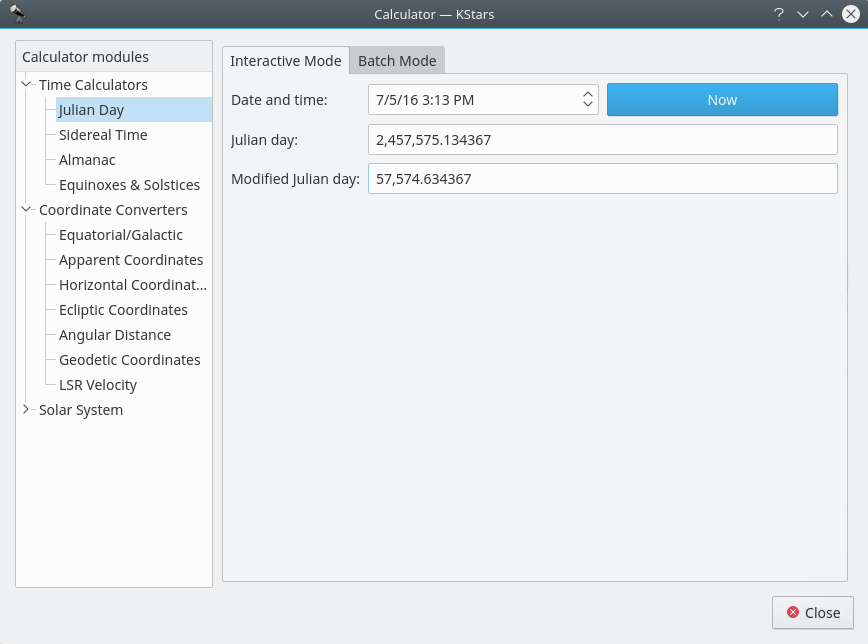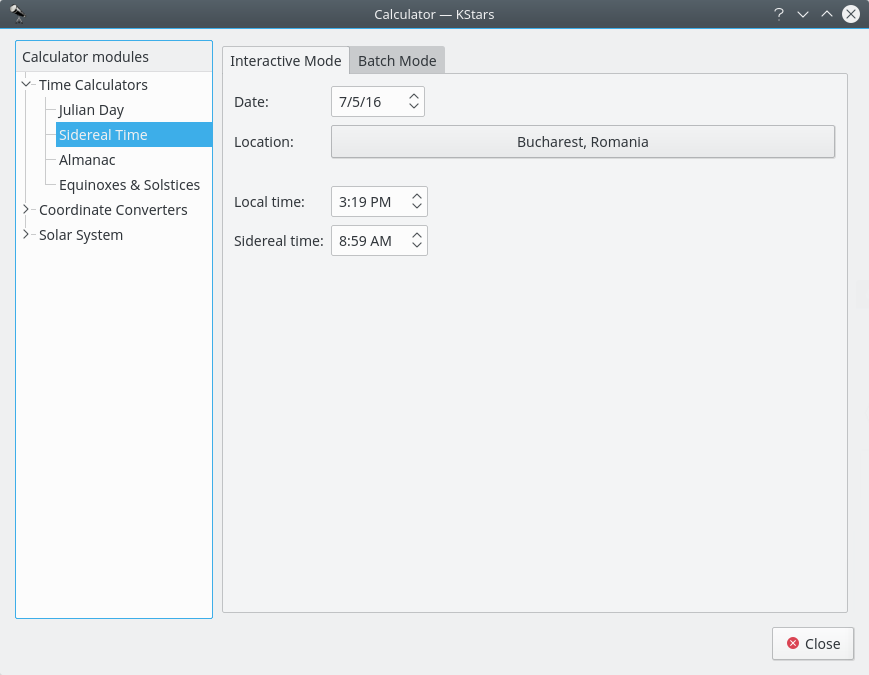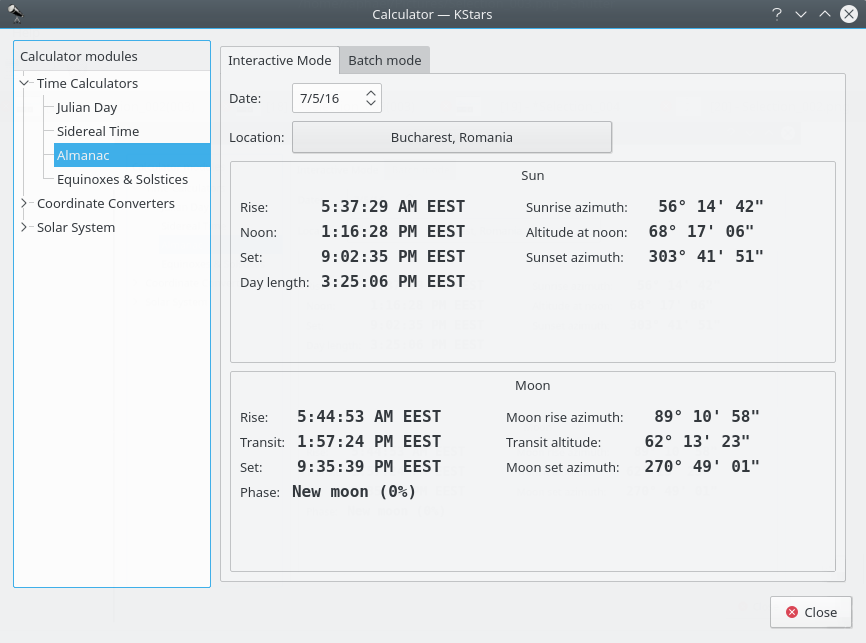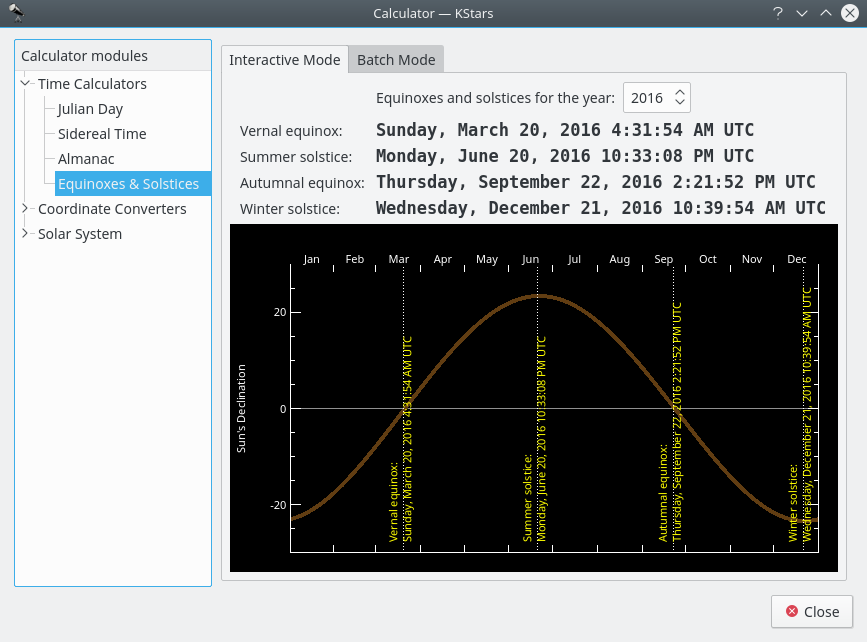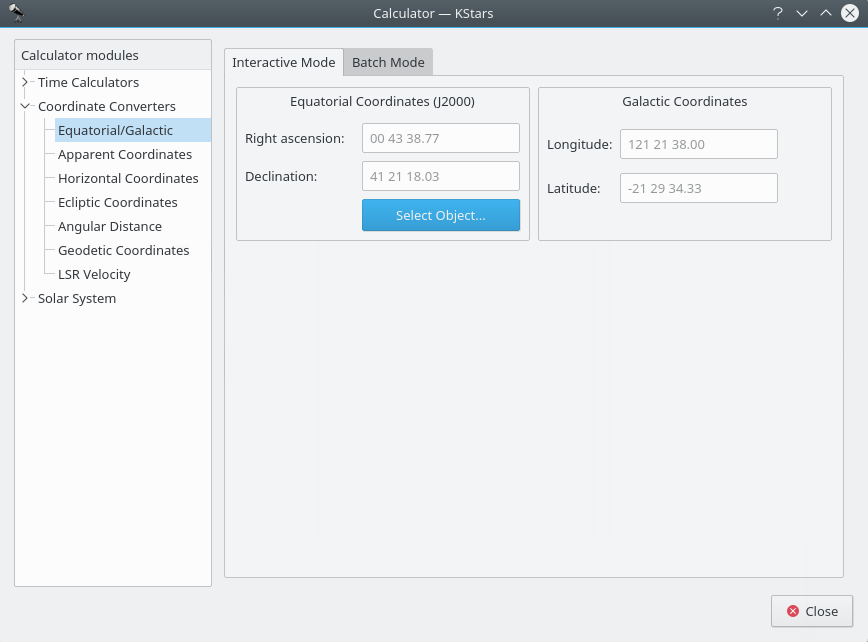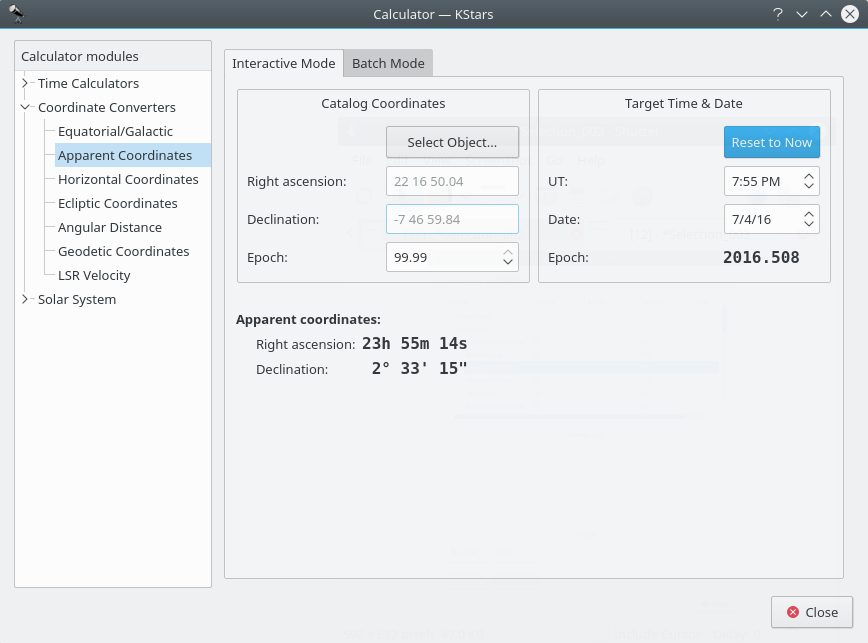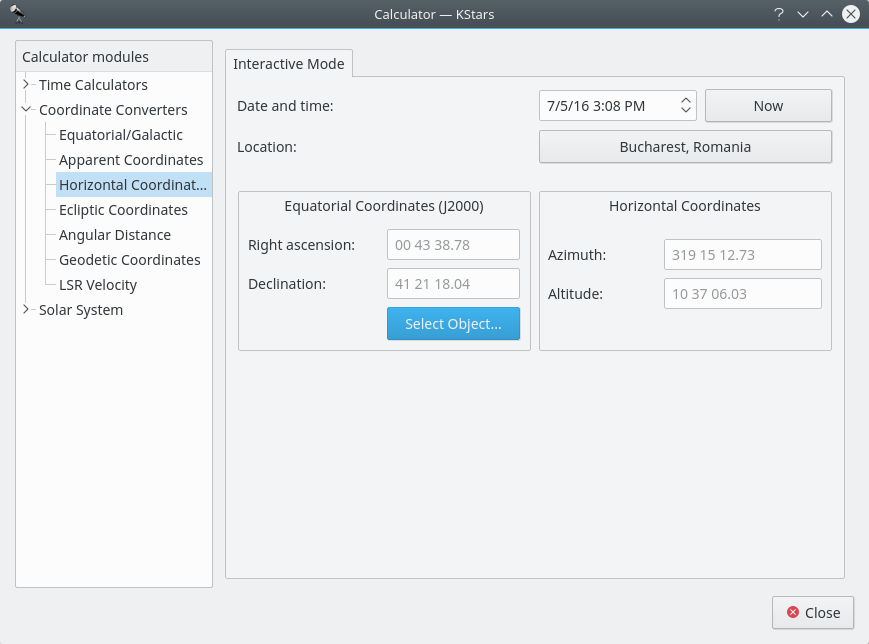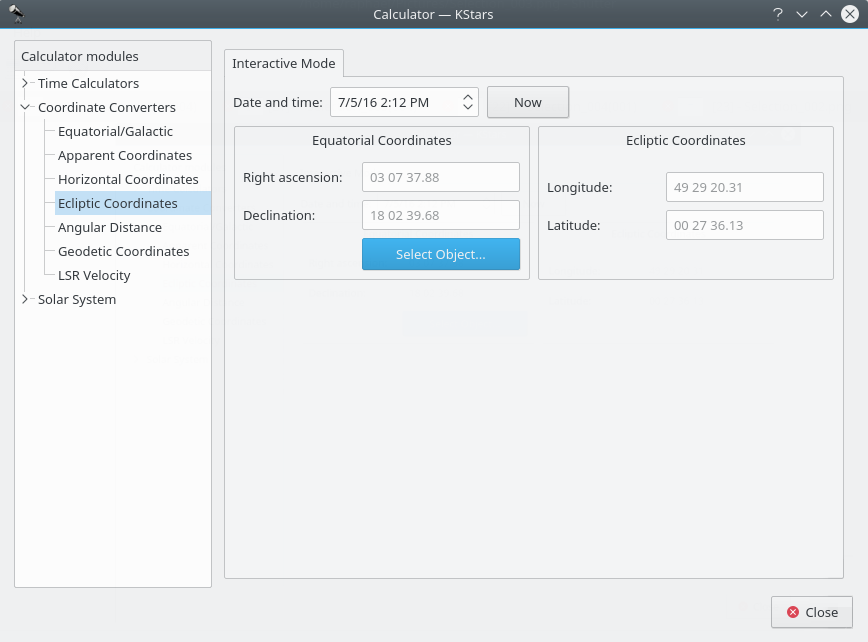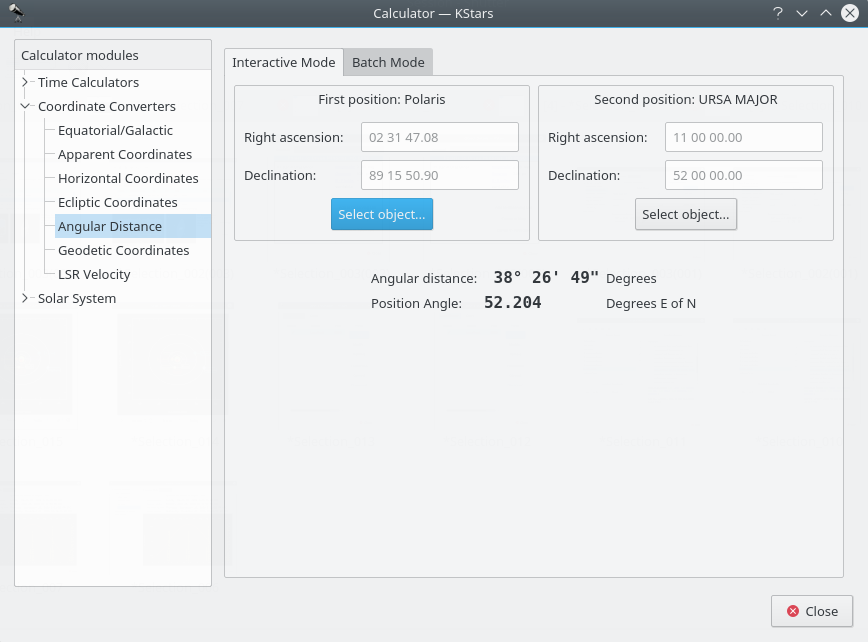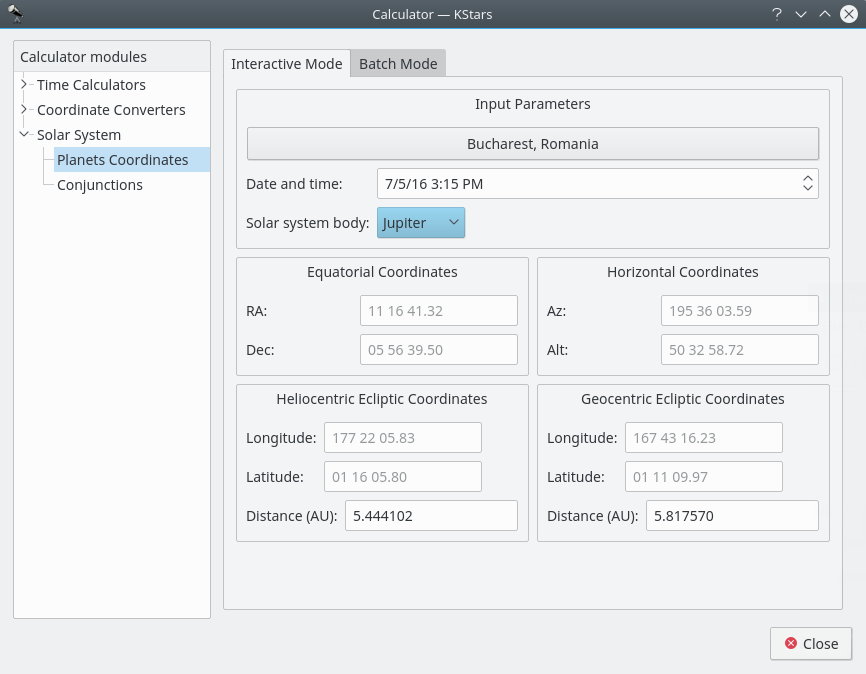De Astrorekenmachine¶
De KStars Astrorekenmachine levert verschillende modules die u direct toegang geven tot algoritmen gebruikt door het programma. De modulen zijn georganiseerd op onderwerp:
Tijdrekenmachines
Omrekenen van coördinaten
Zonnestelsel
Module Juliaanse dag¶
Deze module converteert tussen de kalender
Datum en tijd:, de Juliaanse dag: en deGewijzigde juliaanse dag:. De Gewijzigde Juliaanse dag is eenvoudig gelijk aan de Juliaanse dag - 2.400.000,5.Bij het gebruiken van deze module vult u een van de drie soorten data in, waarna de hiermee corresponderende waarden in de andere twee datumstemen worden getoond. U kunt ook de huidige datum en tijd instellen door op de knop
Nute klikken.Er is een bulkmodus voor deze module. Om het te gebruiken, genereer eenvoudig een invoerbestand waarvan de regels elk een aantal waarden bevatten voor de invoerparameter: “Datum en tijd”, “Julian day” of “Modified Julian day”. Specificeer daarna de invoer- en uitvoerbestandsnamen en druk op de knop
Berekenenom het uitvoerbestand te genereren. Het uitvoerbestand zal waarden bevatten voor de andere twee complementaire parameters. Bijvoorbeeld, als uw invoerbestand een set waardenDatum en tijd:bevatten, dan zal elke regel van het uitvoerbestand waarden voorJulian day:enModified julian day:bevatten. U kunt de uitvoer direct in KStars lezen door indrukken van de knopUitvoer bekijken....Tip
Oefening:
Met welke kalenderdatum komt MJD=0,0 overeen?
De module Sterretijd¶
Deze module converteert tussen Universal Time en Lokaal Sterrentijd. Selecteer eerst een geografische locatie en een datum voor de berekening. Daarna zal de overeenkomstige waarde voor de andere Tijd worden getoond.
Er is een bulkmodus voor deze module. Om het te gebruiken, genereer eenvoudig een invoerbestand waarvan de regels elk waarden voor de invoerparameter bevatten:
Bereken sterretijdofBereken standaard tijduit het linker afrolval. U kunt deDatum:enLocatie:zetten in het huidige venster of u kunt KStars vertellen om deze waarden uit hetInvoerbestand:te lezen. Specificeer daarna de invoer- en uitvoerbestandsnamen en druk op de knopBerekenenom het uitvoerbestand te genereren. Het uitvoerbestand zal waarden bevatten voor de bijbehorende parameter. Bijvoorbeeld, als uw invoerbestand een set waarden “standaard tijd” bevat, dan zal elke regel van het uitvoerbestand waarden voor “sterrentijd” bevatten. U kunt de uitvoer direct in KStars inlezen door op de knopUitvoer bekijken...te drukken.
Module Dagduur¶
Deze module berekent de lengte van de dag, en ook de tijdstippen van opkomst, doorgang door de meridiaan (middag) en ondergang van de zon, voor een willekeurige atum en plaats op aarde. Kies eerst de gewenste geografische coördinaten, waarna deze gegevens worden berekend en getoond.
Module Equinoxen en solstitiën¶
De module Equinoxen en Solstices berekent de datum en tijd van een equinox of solstice voor een gegeven jaar. U specificeert het jaar en de datum en tijd van de gebeurtenis (Lente-quinox, Zomerzonnewende, Herfst-equinox of Winterzonnewende) worden getoond.
Er is een bulkmodus voor deze module. Om het te gebruiken, genereer eenvoudig een invoerbestand waarvan de regels elk een jaar bevatten waarvoor de gegevens van Equinox (dag- en nachtevening) en Solstice (zonnewende) berekend zullen worden. Specificeer daarna het invoer- en uitvoerbestand en druk op de knop
Berekenenom het uitvoerbestand te genereren. Elke regel in het uitvoerbestand bevat het invoerjaar en de datum van elke gebeurtenis. U kunt de uitvoer ook direct in KStars lezen door op de knopUitvoer bekijken...te drukken.
Module Equatoriale/Galactische coördinaten¶
Deze module converteert van Equatoriale coördinaten naar Galactische coördinaten en omgekeerd. Vul de waarden van de coördinaat in in ofwel de sectie
Galactische coördinatenofEquatoriale coördinaten (J2000). Als alternatief zet de equatoriale coördinaten door een object te selecteren met de dialoogObject zoeken. Daarna zullen de bijbehorende coördinaten ingevuld worden.Er is een bulkmodus voor deze module voor het converteren van een aantal coördinatenparen tegelijk. U moet een invoerbestand maken waarin elke regel twee waarden bevat: het invoercoördinatenpaar (ofwel Equatoriaal of Galactisch). Specificeer daarna welke coördinaten u gebruikt als invoer en identificeer het invoer- en uitvoerbestand. Druk tenslotte op de knop
Uitvoerenom het uitvoerbestand te genereren, die de geconverteerde coördinaten zal bevatten (Equatoriaal of Galactisch; de tegenhanger van wat u koos als invoerwaarden).
Module Schijnbare coördinaten¶
De module Schijnbare coördinaten converteert de catalogus coördinaten van een punt in de hemel naar zijn schijnbare coördinaten* voor elke datum. De coördinaten van objecten in de hemel zijn niet vast, vanwege precessie, nutatie en aberratie. Deze module neemt deze effects in rekening.
Om de module te gebruiken, voer eerst de gewenste doeldatum en tijd in in de sectie
Doeltijd & Datum. Voer daarna de cataloguscoördinaten in in de sectionCataloguscoördinaten. Als alternatief kunt u de cataloguscoördinaten instellen door een object te selecteren met de dialoogObject zoeken. U kunt hier ook de epoch van catalogus specificeren (gewoonlijk 2000,0 voor moderne objectcatalogi). Daarna zullen de coördinaten van het object voor de doeldatum getoond worden in de sectieSchijnbare coördinaten:.
Module Horizontale coördinaten¶
Deze module converteert van Equatoriale coördinaten naar Horizontale coördinaten. Selecteer eerst de datum, tijd and geografische coördinaten voor de berekening. Vul daarna de te converteren equatoriale coördinaten in of gebruik de dialoog
Object zoekenin de sectieEquatoriale Coördinaten (J2000). De overeenkomstige Horizontale coördinaten zullen getoond worden in de sectieHorizontale Coördinaten.
Module Ecliptische Coördinaten¶
Deze module converteert tussen Equatoriale coördinaten en Ecliptische coördinaten. Selecteer eerst
Datum en tijd:. Vul daarna de coördinatenwaarden in in ofwel de sectieEcliptische CoördinatenofEquatoriale Coördinaten. Als alternatief zet de equatoriale coördinaten door een object te selecteren met de dialoogObject zoeken. Daarna zullen de bijbehorende coördinaten ingevuld worden.
Module Hoekafstand¶
Het hulpmiddel Hoekafstand wordt gebruikt voor het berekenen van de hoekafstand tussen twee punten aan de hemel. U geeft eenvoudig de Equatoriale coördinaten op van de twee punten, waarna u de hoek tussen die twee punten kunt aflezen.
Deze module heeft een stapelmodus, voor het in een keer omzetten van diverse coördinatenparen. U moet een invoerbestand aanmaken, met op elke regel tot vier waarden: de Rechte klimming beginpunt, de Declinatie beginpunt, de Rechte klimming eindpunt, de Declinatie eindpunt. Standaard moet elke regel vier getallen bevatten, voor de RK en Dec waarden van puntenparen. Ook kunt u in het paneel van de rekenmachine een enkele waarde opgeven voor elk van deze coördinaten (de hiermee overeenkomende waarden in het invoerbestand moeten hierbij worden overgeslagen, als ze in de rekenmachine worden opgegeven).
Als het invoerbestand en een uitvoerbestand zijn opgegeven drukt u op
Berekenenwaarna u het uitvoerbestand verkrijgt.
Module Geodetische coördinaten¶
Het normale geografische coördinatensysteem neemt aan dat de Aarde een perfecte bol is. Dat is bijna waar, dus voor de meeste doelen zijn geografische coördinaten fijn. Als erg hoge precisie is vereist, dan moeten we de echte vorm van de Aarde in rekening brengen. De Aarde is een ellipsoïde; De afstand rond de equator is ongeveer 0.3% langer dan een Groot cirkel die door de polen gaat. Het Geodetische coördinatensysteem houdt met deze ellipsoïdale vorm rekening en drukt de positie op het oppervlak van de Aarde in Cartesiaanse coördinaten (X, Y en Z) of in Geografische coördinaten (Lengtegraad, Breedtegraad en Hoogte).
Om de module te gebruiken, selecteer eerst welke coördinaten u wilt gebruiken als invoer in de sectie
Selecteer Invoercoördinaten: keuzerondjesCartesischeofGeografische. Selecteer daarna een ellipsoïdaal model en vul de invoercoördinaten in in ofwel de sectieCartesische coördinatenof deGeografische coördinaten. Wanner u op de knopConverterendrukt, zullen de bijbehorende coördinaten ingevuld worden.De module bevat een bulkmodus voor het converteren van een aantal coördinatenwaarden tegelijk. U moet een invoerbestand maken waarin elke regel tot drie getallen bevat: De invoercoördinatenwaarden (ofwel Cartesiaanse of Geografische). Specificeer daarna welke coördinaten u gebruikt als invoer en identificeer de invoer- en uitvoerbestandsnamen. Druk tenslotte op de knop
Uitvoerenom generate het uitvoerbestand te genereren, die de geconverteerde coördinaten (Cartesiaanse of Geografische; het bijbehorende van wat u koos als de invoerwaarden).
Module Planeetcoördinaten¶
De module Planeetcoördinaten berekent positionele gegevens voor elk belangrijk lichaam in het zonnestelsel, voor elke tijd en datum en elke geografische locatie. Selecteer eenvoudig uit de afrollijst
Zonnestelsellichaam:en specificeer de gewenste datum, tijd en geografische coördinaten (deze waarden zijn voor-ingesteld naar de huidige instellingen van KStars). Daarna worden de Equatoriale, Horizontale en Ecliptische coördinaten van het lichaam berekend en getoond.Ere is een bulkmodus voor deze module. U moet een invoerbestand maken waarin elke regel waarden specificeert voor de invoerparameters (zonnestelselsysteem, datum, tijd, lengtegraad en breedtegraad). U kunt kiezen om een constante waarde voor sommige van de parameters in het rekenmachinevenster (deze parameters zouden in het invoerbestand worden overgeslagen). U kunt ook specificeren welk van de uitvoerparameters (Equatoriale, Horizontale, Heliocentrische ecliptische en Geocentrische ecliptische cöordinaten) berekend zouden moeten worden. Specificeer tenslotte de invoer- en uitvoerbestandsnamen en druk op de knop
Uitvoerenom het uitvoerbestand met de berekende waarden te genereren.

